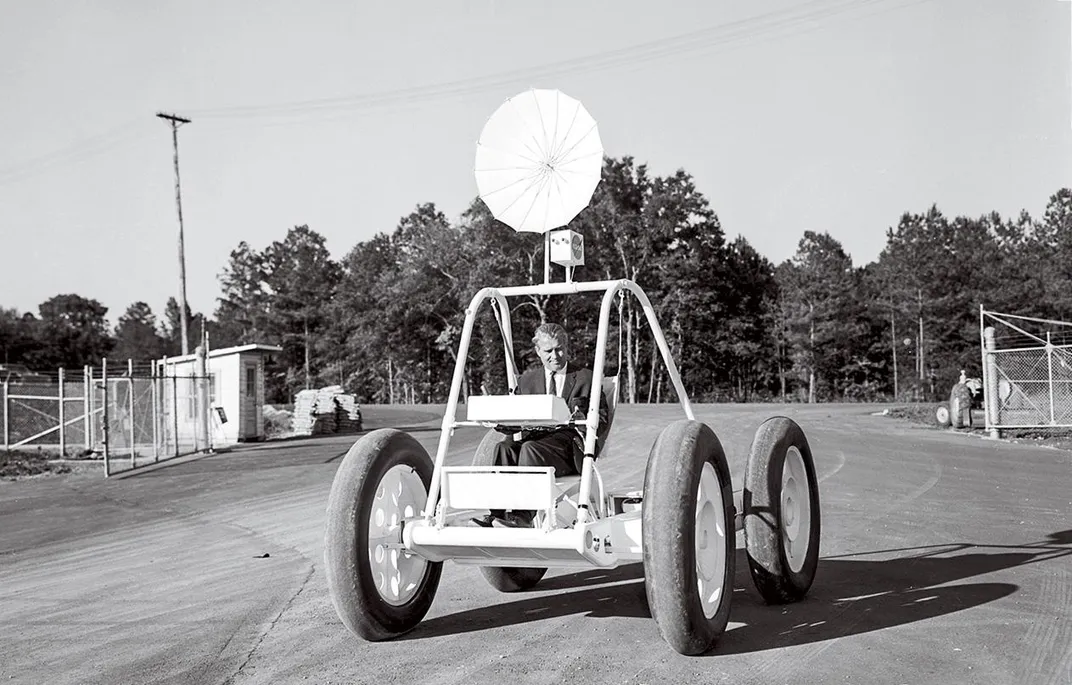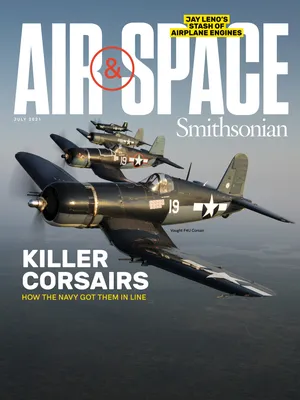First Car on the Moon
Before Apollo 15, astronauts could explore only as far as they could walk.
:focal(2139x1137:2140x1138)/https://tf-cmsv2-smithsonianmag-media.s3.amazonaws.com/filer/d1/e0/d1e0c1a3-2a01-428d-9e49-426588911ed0/03c_jj2021_as15-86-11603_live.jpg)
When Apollo 14 landed astronauts on the moon for the third time in February 1971, it was met with a week-long yawn by the press and the public. The TV networks carried live coverage of the launch and paid some mind to the long translunar coast, where misfortune had called on Apollo 13, but offered only occasional snippets of Alan Shepard and Ed Mitchell’s time on the lunar surface. News from Fra Mauro was dutifully passed along by the country’s newspapers, but with palpable lack of enthusiasm. America had grown jaded about moon missions, it seemed.
But fact was, the second and third lunar landings made for lousy TV. To viewers, they looked pretty much the same as Apollo 11: The astronauts were on foot. The TV camera was stationary and positioned near the lun175
ar module. Its low-resolution footage captured the crew bouncing around base camp, doing nothing especially stirring. In fact, Apollo 14’s single made-for-TV moment is the only thing many older Americans remember about it: Alan Shepard’s golf shot that went for “miles and miles” in the weak lunar gravity.
Apollo 15 was different.
Weeks ahead of time, even months, it was plain that this would be another kind of mission. Newspapers reported about it with renewed excitement: It would be longer, three days, with three ventures outside the lander. These astronauts would be real explorers, engaged in real science. A much-improved TV camera would follow them wherever they went. And, most important of all, they would have a car.
Journalists couldn’t stop talking about the rover. They were fond of calling it a “moon buggy,” to the chagrin of NASA’s Marshall Space Flight Center, which oversaw its development. At the same time, they seemed to have a genuine hunger for details about its design, performance, and potential contributions to lunar science. They wrote about its sky-high cost. By launch day, the press seemed to reach consensus that each flight-ready example represented an $8 million investment—a figure that involved some magical accounting, as it fell short of reality by nearly $5 million. Even at the lowball price, some stories called it the most expensive car ever made, the more so because it would be abandoned after just three days of driving.
On Saturday, July 31, 1971, the morning after the lunar module Falcon descended to the surface, papers across the country illustrated their coverage with a detailed diagram of the rover’s deployment from the lander. That same morning, scores more published an artist’s rendition of the rover conquering the lurrain. The New York Times devoted nearly a full page to the machine. The networks began their live coverage shortly before the crew deployed the rover, followed its travels for hours, and did the same for its second venture from base.
Even advertisers piggybacked on rover fever. Consider the ad placed in the Daily Leader of Pontiac, Illinois, six days before the landing. “Apollo 15 will carry a Moon Buggy, and this Buggy has a color TV camera,” it read. “Our TV screen will seem like a window on the Moon Buggy. To get a good view of the moon, you should have a nice clear window. A new RCA color TV from Schlosser’s may be what you need. Why not be prepared for a thrilling ride on the moon?”
A BUMPY START
The setting for the rover’s maiden voyage was well chosen: the Hadley-Apennine region, an undulating plain rimmed on two sides by mountains the size of Everest and on a third by a canyon almost a mile wide and a thousand feet deep. In place of the featureless gray flatlands that TV viewers had seen in past Apollo coverage was a moonscape of extremes, a backdrop without earthly equivalent.
On the afternoon of July 30, Dave Scott and Jim Irwin landed a mile from the canyon and three from the nearest mountain. A short time later, during a “stand-up EVA” (or extravehicular activity) from the lunar module’s top hatch, Scott took a look around. One aspect of the place leapt out: It was relatively free of boulders and other obstructions. “Trafficability looks pretty good,” he told Houston. “It’s hummocky—I think we’ll have to keep track of our position. But I think we can manipulate the rover fairly well in a straight line.”
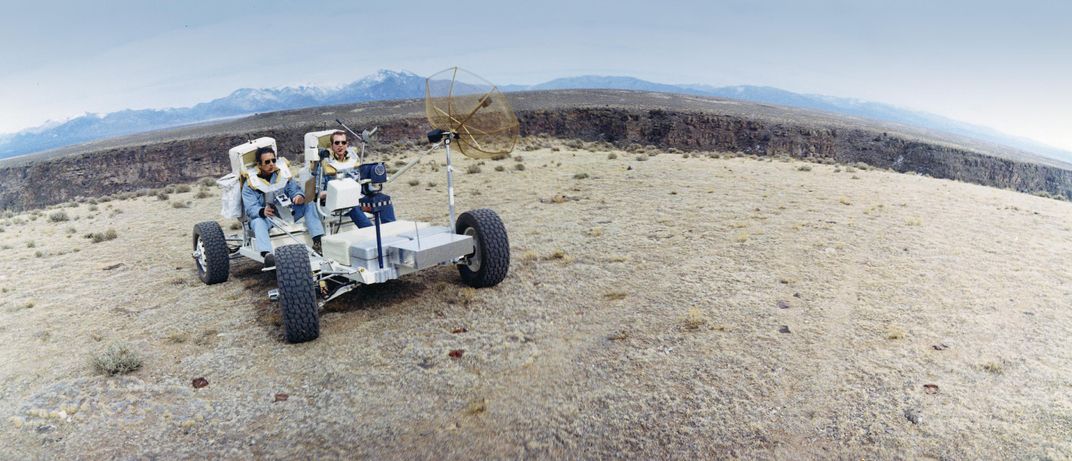
And so, the next morning, America watched over breakfast as the astronauts stepped onto the plain—more formally, and ominously, known as the Marsh of Decay—and released the mission’s star attraction from its stowage place on the lander.
Ferenc “Frank” Pavlics and Sam Romano of General Motors’ Delco Research Laboratories in Santa Barbara, California, were at Mission Control as technical advisors. These two engineers—a Hungarian immigrant who had arrived in America just as the space race was getting under way and a New Jersey-born Navy veteran—led the team responsible for designing much of the first car on the moon. When they saw the rover unfold and drop to the surface, “we were all cheering,” Pavlics recalled. “I was sitting on needles. It was satisfying, and very exciting, to see the thing working like that.”
But then the moon buggy hit a few snags. It hung up briefly on the saddle linking it to the lander. The astronauts twisted and tugged until it came loose. A few minutes later, as Scott unfolded his seat, the Velcro holding it in place proved stronger than lunar gravity, and he almost yanked the entire vehicle off the ground. Then, as Irwin filmed him, Scott climbed aboard, eased the machine forward, and discovered that he couldn’t turn the front wheels. Irwin confirmed the bad news. “Got just rear steering, Dave.”
Their capsule communicator, or capcom—a fellow astronaut named Joe Allen, through whom Mission Control routed all messages to and from the crew—suggested a number of switch combinations on the control panel. “Still no forward steering,” Scott told him.
In Houston, Romano, GM’s program manager for the Lunar Roving Vehicle, sat horror-struck. “I was sitting in the Mission Control Center, in the third row,” he told a documentary filmmaker many years later. “Wernher von Braun was in the fifth row. So when they said, ‘The front wheels are not steering,’ my God, I was very, very nervous. The back of my neck began to swell, get red. My ears were red.”
Pavlics, watching nearby, thought he knew what was up. A tiny component in the steering electronics, called a potentiometer, was failing to carry an electrical signal. “Sometimes the metal-to-metal connection in the potentiometer didn’t make contact, and that was happening there,” he told me. “So I suggested that they should exercise the hand controller, to move the two pieces together.”
On the Hadley Plain, Dave Scott waited for instructions. Would Houston scrub using the rover? If so, Apollo 15 was going to be far less ambitious than everyone had hoped. Steering with just the rear wheels was certainly doable, and Mission Control’s own rules for Apollo 15 allowed it, but NASA typically insisted on redundancy.
Seconds passed before Allen told him, “Press on.” Pavlics’ fix would wait; the clock was running. Scott and Irwin hurried to attach the lunar communication relay unit, TV camera, and antennas and to load tools into the storage pallet behind their seats.
Irwin climbed on. “You really sit high,” he said. “It’s almost like standing up.” He reached for his maps and found that his pressurized suit bent so little that he couldn’t stretch that far. Minus Earth’s gravity and atmosphere, their suits were fatter and stiffer, and the astronauts’ lighter weight gave them less leverage. He fumbled with his seat-belt. It wouldn’t close. “I think it’s too short, Dave.”
Scott came around the rover to help. “Yeah, sure is.”
“Don’t waste time on it,” Irwin told him. “I’ll just hang on.”
“No,” Scott said, making perhaps his wisest decision of the day. “We can’t lose you now. Got too far to go.” He got the belt latched, climbed back in, and buckled his own belt. “Okay, Jim, here we go.”
“Okay,” Irwin said, “we’re moving forward.”
“Whew!” Scott said. “Hang on!”
THE FIRST LUNAR DRIVE
So began the adventures of LRV-1. Off the crew drove into the lunar unknown, in what was, it’s important to remember, largely a 1969 General Motors product, as GM built the wheels, drivetrains, steering, and suspension system. If you’ve driven cars of that vintage, you know that they had as much in common with the wheezy horseless carriages of the last century’s turn as they did with the computer-controlled, airbag-equipped, wonderfully reliable appliances we drive today. The rover was not a car, in a great many senses—as Sonny Morea, who managed the project for NASA’s Marshall center, insists, it was a spacecraft on wheels. Whatever you call it, Scott and Irwin intended to drive it beyond sight of their only way home.
They were up for it. Scott, the mission’s 39-year-old commander, was an Air Force colonel, test pilot, and veteran of two previous spaceflights, on Gemini 8 and Apollo 9. Irwin, Apollo 15’s lunar module pilot, was 41 and a lieutenant colonel in the Air Force. Born in Pittsburgh, he had talked about going to the moon since childhood.
Of course, there was a backup plan: If the rover broke down, they would ditch it and walk home to the lunar module. How far they could walk was limited by the stores of air and cooling water in their backpacks. At most, they could cover about six miles. So, while the rover had enough juice in its batteries to cover 40 or more miles (Boeing, the prime contractor, claimed 57), wherever they drove had to fall within that six-mile radius.
Because their air and water would dwindle over the course of their workday, they’d start each drive by heading to their farthest planned destination, then work their way back toward the comparative safety of the lunar module.
On this first foray, Scott and Irwin were scheduled to drive about three straight-line miles to a mountainside, stopping at a nearby crater on the way. They would sample rocks at both places and make a couple of additional stops on the return journey.
That first drive invited sensory overload. Mt. Hadley, deep in shadow, dominated the view to the north. The mountain erupted from the plain without a foothill; at 15,000 feet from base to peak, it outreached the Rockies. To the south rose Mt. Hadley Delta—their destination today—about 3,000 feet shorter but still lofty enough to rank among the great mountains of Earth.
Off to the east between those massifs stretched the Swann Range, lower peaks that Scott and Irwin had informally named after Gordon Swann of the U.S. Geological Survey, who was overseeing the mission’s science. To the west, and dead ahead, lay the canyon, the Hadley Rille.
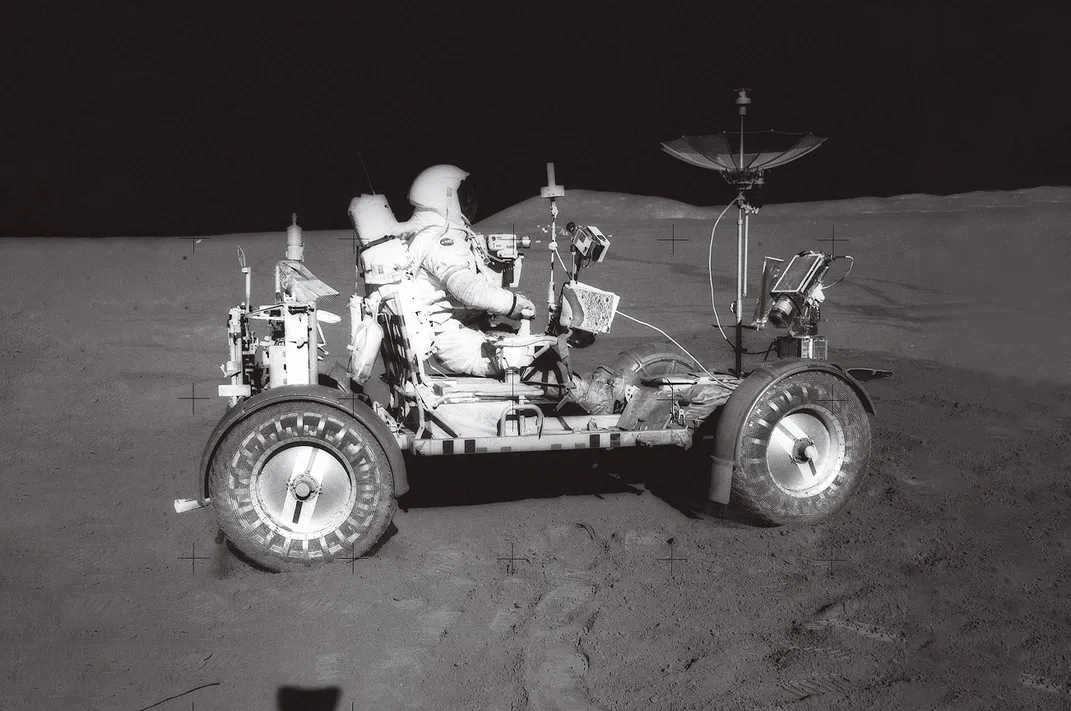
Within minutes, they came to a rapid series of insights. One: What had appeared smooth plain was not, not at all. It was rippled with rises and falls, littered with small rocks, and everywhere pocked with craters. “Well,” Scott said early in their drive, “I can see I’m going to have to keep my eye on the road.”
Two: Even with their navigation system and maps, reading their surroundings was difficult. Landmarks were surprisingly elusive. Like the Apollo 14 astronauts, they found that without trees, clouds, or other visual touchstones, it was hard to pin down distances. Hadley Delta, looming high overhead, looked close enough to touch.
Three: Their heading relative to the sun played a key role in their ability to see where they were going. When they looked “down sun,” or with the sun directly behind them, the details of the topography disappeared—shadows were hidden by the objects that cast them. On top of that, lunar regolith is so highly reflective that they were all but blind to the presence of humps, small craters, even enormous holes and dropoffs.
The rover exacerbated the challenges of down-sun travel, as small craters and rocks sprang into view with the machine almost upon them. Scott’s yells of “Whoa! Hang on!” punctuated their radio chatter.
And four: They wouldn’t have lasted a minute without their seat-belts. The rover’s wheels smacked into obstacles constantly. The suspension absorbed the hard jolts, but even so, at least one wheel was often off the ground. The car rose and fell like a bucking bronco, as Irwin put it, and fishtailed like a speedboat when Scott attempted high-speed turns. And by high speed, I mean six miles per hour.
Less than a mile from the lunar module, they came to the edge of Hadley Rille. It yawned wide before them, its sides riding deceptively gentle slopes to a floor that Irwin guessed to be about 650 feet wide. The astronauts had trained along the Rio Grande Gorge to get a foretaste of working on its rim. But the rille, the remnant of an ancient lava flow, dwarfed the New Mexico analog where they’d received their driver’s ed.
Scott noted that while the canyon’s far side was littered with boulders, its near side was smooth. “It almost looks like we could drive down on this side, doesn’t it?” he asked Irwin.
“Stand by on that, Dave,” a nervous Allen radioed back. The astronauts laughed. “I’m sure we could drive down,” Irwin replied. “I don’t think we could drive back out.”
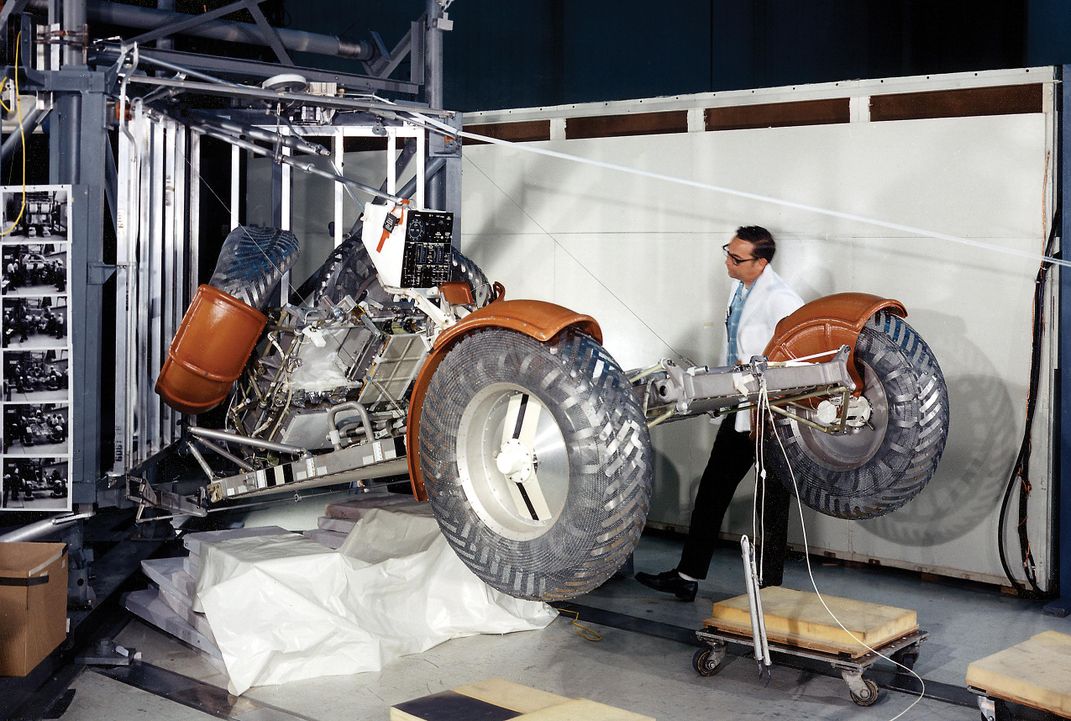
ON HADLEY DELTA
That first drive culminated a generation’s thought and labor to put wheels on the moon. It had been 19 years since Wernher von Braun’s speculative stories in Collier’s magazine about a vehicle for lunar exploration. Hundreds of people had devoted themselves to the dream since. Now it seemed worth the trouble: LRV-1’s first journey was flawless, save for the front steering.
The second drive erased even that small qualification. When Scott activated the rover the next day, he discovered that, for reasons neither he nor Houston could fathom, the front steering worked. “You know what I bet you did last night, Joe?” he asked Allen. “You let some of those Marshall guys come up here and fix it, didn’t you?”
They set out again, roller-coastering in and out of old and eroded craters. Whenever Scott’s gaze strayed from the ground directly ahead of them, he almost always regretted it: The ground was perforated with younger, sharper-edged, deeper holes, and they slammed into several. Rocks appeared with increasing frequency and grew in size—six inches to a foot across, most of them, though some measured two feet. The rover had 14 inches of ground clearance. Scott cut a snaking route to avoid the biggest.
He braked to a stop high up the side of Hadley Delta. “By golly, Joe, this rover is remarkable,” Scott reported as they struggled to find their footing on an 11-degree incline. The lunar module, more than three miles away, was a distant blip of silver and orange in a field of gray. They had already traveled far beyond the reach of any previous mission, and had done it in so little time that they had enough air and water for detailed science.
They made several stops on the mountainside, at one recovering a chunk of ancient lunar crust more than four billion years old. In Houston, Apollo 15’s lead flight director, Gerry Griffin, no doubt had the discovery in mind when he called the second EVA “the greatest day of scientific exploration, certainly, that we in the space program have ever seen—and possibly of all time.”
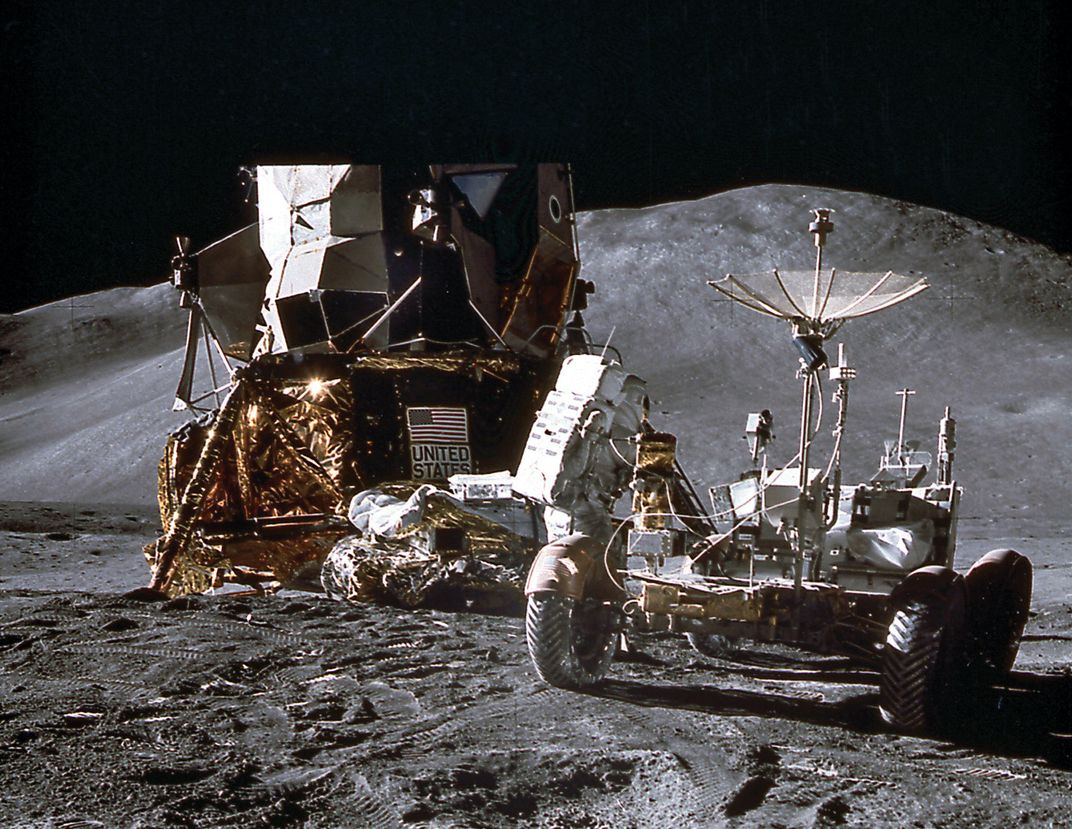
In the weeks after the mission, NASA’s Marshall Center obsessed over the rover’s minor failures—in particular, the front steering glitch during the first EVA. The center’s Astrionics Lab was on the case even as Apollo 15 left the moon, theorizing that the snag was most likely due to an open circuit or a mechanical hang-up that worked itself out during the first drive. By late in the month, the labs were considering a third culprit: the potentiometer in the hand controller that Pavlics had suspected. They never pinned it down. The Manned Spacecraft Center in Houston, not quite so obsessive, blamed “MEF,” or mysterious evil forces.
Just about everyone else marveled at the little machine’s performance. LRV-1 had proven safe and reliable. Its wheels maintained traction even in the soft, steep soil of Hadley Delta. The motors and transmissions worked flawlessly and ran at far cooler temperatures than expected. The battery temperatures, while higher than predicted, were never too high. The rover’s travels used about half the power that mission planners had forecast, and its suspension toughed its way over some very rugged terrain. “We had almost no right to expect the rover to work so well,” Apollo program boss Rocco Petrone told reporters. “It made the mission.”
Moreover, the machine had upended all assumptions about how much science could be accomplished in a single visit to the moon. Scott and Irwin spent 18 hours and 35 minutes outside, twice Apollo 14’s total. They drove for just over three hours, during which they covered 17.25 miles. At one point, they ranged 3.2 miles from their lander. They brought back 170.4 pounds of samples. Millions of Americans watched the rover in action, and the media covered the Falcon lunar lander’s three-day stay with gusto. “In brief, the LRV performed as planned,” Sonny Morea wrote rather modestly to his colleagues, “and none of the problems with the LRV can be classified as any worse than a deviation.” The rover so impressed the rest of NASA that Lee Scherer, director of the Apollo Lunar Exploration Office at headquarters, promised it would be trusted to assume an even bigger role in the missions to come. “We are going to plan longer traverses now than we would have planned several weeks ago,” he said.
In Santa Barbara, the GM team celebrated. On the evening of August 7, 1971, Romano, Pavlics, and another GM engineer, Joe Finelli, cohosted a splashdown party at Romano’s place. Hundreds of guests jammed the house and backyard. “It was crazy,” Romano’s son Tim told me. “There were cars lined up and down the street. People were everywhere—neighbors and people from GM. It must have been everyone they knew.”
Excerpted and condensed from Across the Airless Wilds: The Lunar Rover and the Triumph of the Final Moon Landings, by Earl Swift. HarperCollins, 2021. Earl Swift is the author of eight books, including the New York Times bestseller Chesapeake Requiem. He lives in the Blue Ridge Mountains west of Charlottesville, Virginia.
A Note to our Readers
Smithsonian magazine participates in affiliate link advertising programs. If you purchase an item through these links, we receive a commission.

/https://tf-cmsv2-smithsonianmag-media.s3.amazonaws.com/filer/6a/89/6a89c4fa-c707-4dd2-9d53-12cc5521eb17/03s_jj2021_0401768_live.jpg)
